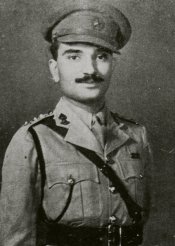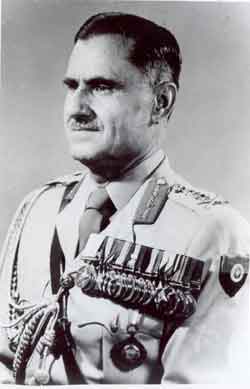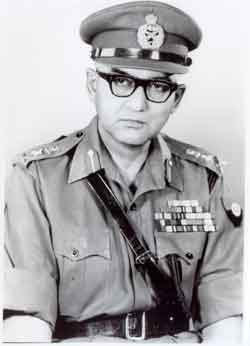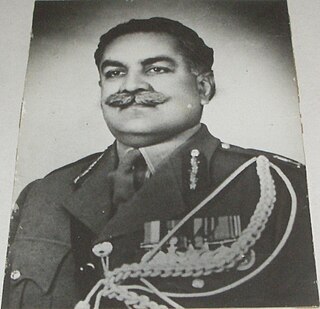
Lieutenant General Premindra Singh Bhagat, PVSM, VC was a general in the Indian Army and an Indian recipient of the Victoria Cross, the highest and most prestigious award for gallantry in the face of the enemy that can be awarded to British and Commonwealth forces. The Victoria Cross was conferred on him for his actions in the Sudan Theatre during World War II.

General Tapishwar Narain Raina, best known as T.N. Raina, was a senior army officer and a diplomat who served as the 9th Chief of the Army Staff of the Indian Army between 1975 and 1978.

General Kodendera Subayya Thimayya was the 3rd Chief of Army Staff from 1957 to 1961 during the crucial years leading up to the conflict with China in 1962. Thimayya was the only Indian to command an Infantry brigade in battle during the Second World War and is regarded as the most distinguished combat officer the Indian Army has produced. After the Korean War, Thimayya headed a United Nations unit dealing with the repatriation of prisoners of war. After his retirement from the Army, he was appointed Commander of the United Nations Peace Keeping Force in Cyprus from July 1964 to December 1965 and died in Cyprus while on active duty on 18 December 1965.

Lieutenant General Joginder Singh Dhillon was an officer in the British Indian Army and then the Indian Army. Dhillon Born in Jat Sikh Family. He was the first Army officer to be awarded the Padma Bhushan, given for his role in the 1965 India-Pakistan War, where he was the general officer commanding corps.

General Kotikalapudi Venkata Krishna Rao, was a former chief of the Indian Army and a former governor of Jammu and Kashmir, Nagaland, Manipur and Tripura.
Lieutenant General Zorawar Chand 'Zoru' Bakshi PVSM, MVC, VrC, VSM was a General Officer of the Indian Army, most widely known as one of the commanders of Indo-Pakistani War of 1965. He also has the distinction of being "India's most decorated General".

General Gopal Gurunath Bewoor PVSM, PB was a senior officer of the Indian Army who served as the 8th Chief of Army Staff, and later an Indian diplomat to Denmark.

Lieutenant-General Kanwar Bahadur Singh, MBE, was a senior officer in the The Kumaon Regiment of Indian Army.

General Pran Nath Thapar was the fourth Chief of Army Staff of the Indian Army. The Sino-Indian War was fought during his term, in which the Indian Army fared poorly. Thapar resigned during the last stages of the war, handing charge to Lt. Gen. J. N. Chaudhuri.

Lieutenant General Jagjit Singh Aurora, was an Indian Army General Officer who was the General Officer Commanding-in-Chief (GOC-in-C) Eastern Command during the third war with Pakistan in 1971. He organised and led the ground forces campaign in the Eastern Front of the war, which led to an overwhelming defeat of the combined Pakistan Armed Forces in East-Pakistan that led to the creation of Bangladesh.

General Satyawant Mallanna Shrinagesh was an Indian military officer who served as 3rd Chief of Army Staff of the Indian Army from 14 May 1955 till 7 May 1957. After retirement he served as the governor of Assam from 14 October 1959 to 12 November 1960 and again from 13 January 1961 to 7 September 1962. He was the governor of Andhra Pradesh from 8 September 1962 to 4 May 1964 and governor of Mysore from 4 May 1964 to 2 April 1965. He also served as principal of the Administrative Staff College of India in Hyderabad, Hyderabad State from 1957 to 1959.
Brigadier John Parashuram Dalvi was an Indian Army officer. During the Sino-Indian War of 1962, he was the commander of the Indian 7th Brigade, which was destroyed, leading Dalvi to be captured by the People's Liberation Army on 22 October 1962.
Lieutenant General Syed Ata HasnainPVSM, UYSM, AVSM, SM, VSM & Bar is a retired General of the Indian Army. His last assignment in service was as the Military Secretary of the Indian Army. Prior to that, he commanded the Indian Army's 15 Corps in the state of Jammu and Kashmir, amongst other appointments. He has also commanded 21 Corps (Strike). In 2018, General Hasnain was appointed Chancellor of Central University of Kashmir.
Lieutenant General Inderjit Singh Gill, PVSM, MC was a general officer in the Indian Army. He was the officiating Director of Military Operations (DMO) of the Indian Army during the Bangladesh Liberation War. He retired in 1979 after serving as the Western Army Commander.
Lieutenant General Shankarrao Pandurang Patil (SPP) Thorat, KC, DSO was a General Officer in the Indian Army. He was the General Officer Commanding-in-Chief Eastern Command in the lead up to the 1962 Sino-Indian War.
Major General Anant Singh Pathania MVC, MC was a decorated Indian Army general; the first Indian to receive a Military Cross in the Second World War, he was also the first Indian commanding officer of the Gorkha Rifles. During the Sino-Indian War of 1962, he commanded the 4th Infantry Division during a critical stage of the conflict where his leadership was criticised.
Lieutenant-General Lionel Protip "Bogey" Sen DSO was a decorated Indian Army general. He served as the Chief of the General Staff during 1959–1961 and commanded the Eastern Command during 1961–1963. He was the general responsible for countering the Chinese invasion of NEFA during the Sino-Indian War of 1962. Sen is also the author of Slender was the Thread, a military history of the Indo-Pakistani War of 1947–1948.
Lieutenant General Naveen Chand Rawlley, PVSM, AVSM, MC was a General Officer in the Indian Army. He served as the General Officer Commanding-in-Chief Eastern Command before taking over as the 5th Vice Chief of the Army Staff.
Lieutenant-General Patrick Oswald Dunn was an Indian Army general. He commanded the I Corps during the Indo-Pak War of 1965 for which he was awarded the third-highest award of India - the Padma Bhushan.

Lieutenant General N. S. Raja Subramani AVSM, SM, VSM is a serving general officer of the Indian Army. He currently serves as the General Officer Commanding-in-Chief Central Command. He earlier served as the Chief of Staff of the Northern Command.










